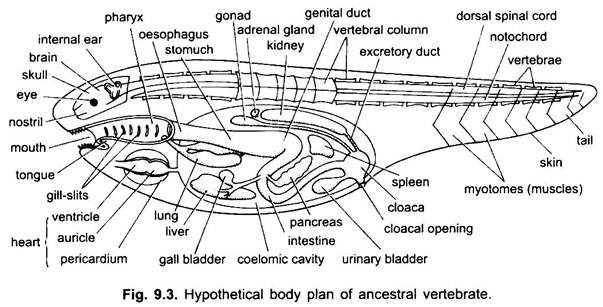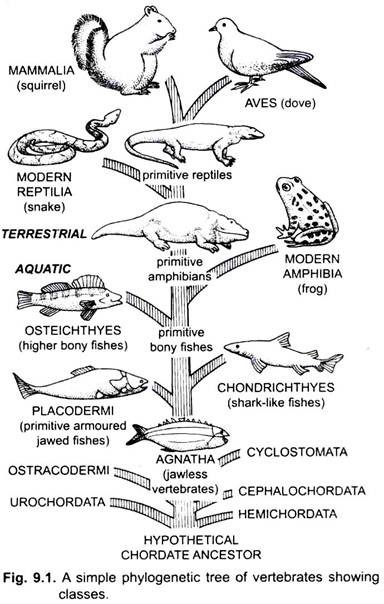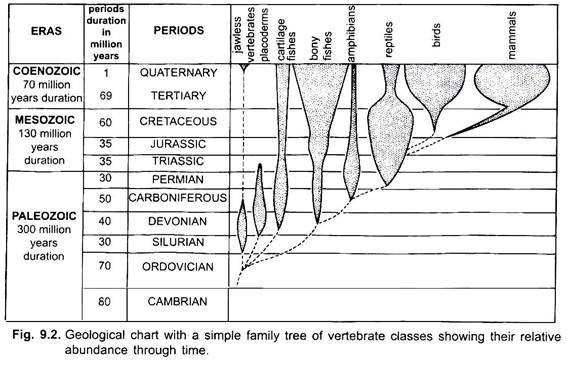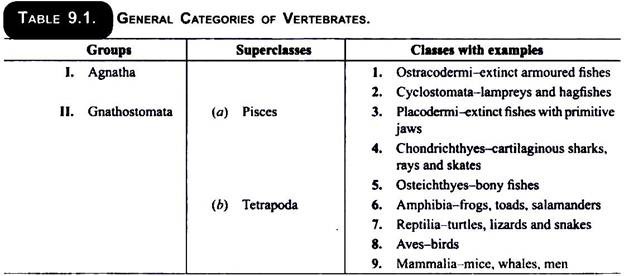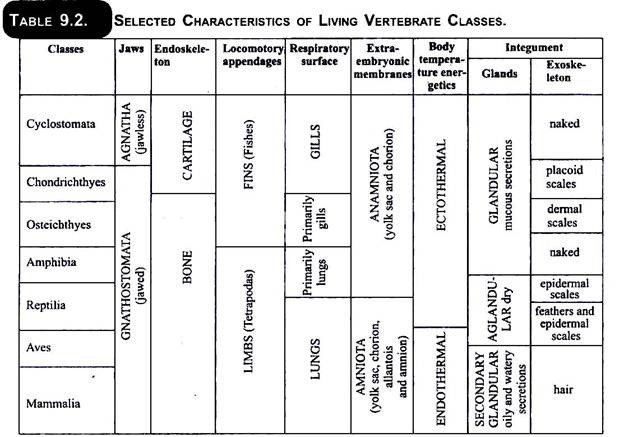Here is an essay on ‘Vertebrates’ for class 11 and 12. Find paragraphs, long and short essays on ‘Vertebrates’ especially written for school and college students.
Essay on Vertebrates
Essay Contents:
- Essay on the Origin of Vertebrates
- Essay on the Phylogeny History of Vertebrates
- Essay on What are Vertebrates?
- Essay on the General Characters of Subphylum Vertebrata
- Essay on the Diversity of Vertebrates
1. Essay on the Origin of Vertebrates:
ADVERTISEMENTS:
The problem of searching into origin and ancestry of vertebrates has long been of particular interest to zoologists. But, like that of most of the animal phyla, the origin of vertebrates also remains obscure. Over the years, several hypothesis have been proposed to explain the origin of vertebrates, but none could stand the test of close scrutiny.
Time of Origin:
The chordates constitute very ancient forms. The earliest known truly vertebrate animals were freshwater forms which were abundant during the late Silurian and middle Devonian periods. Their fossils are collectively known as ostracoderms. Ostracoderms are placed with living cyclostomes (lampreys and hagfishes) in the jawless group called Agnatha.
Ostracoderms, as their name refers to, have their body covered by a dermal bony armour which forms an elaborate rounded solid shield on the head. Like cyclostomes, they had presumably a persistent notochord and no vertebrae. The mouth was anterior, ventral and devoid of jaws and teeth.
They had no paired appendages homologous with those of vertebrates. Paired lateral eyes, median nostril and a median pineal eye were present on the top of the head. A variable number of pharyngeal gill-pouches opened by lateral common or separate gill-openings. They were adapted for filter feeding.
ADVERTISEMENTS:
The fragmentary remains of the invertebrate chordates have been recorded in the Cambrian strata and that of ostracoderms in the middle Ordovician time. The absence of any vertebrate fossils in rocks older than the Cambrian period, permits only speculation about the earlier history of the vertebrates. Which group was ancestral to the first true vertebrates (ostracoderms)? In fact, there have been no fossils intermediate between ostracoderms, which are already vertebrates, and any other earlier group of animals.
As a result, there has been a great deal of speculation about the time of origin and the early progenitors of the vertebrates (chordates). Probably the vertebrate organisation had been evolving for several millions of years before the appearance of the first, late Cambrian fossils. It can be said that the time of origin was not later than the beginning of the Ordovician, if not long before.
Place of Origin:
The place of origin of vertebrates is not definitely known. There is no direct evidence for the exact site of origin. There are evidences that the vertebrates first appeared in the sea and migration into river system took place during the early phase of vertebrate evolution.
In 1900, the American geologist Chamberlain gave the idea of freshwater origin of vertebrates. This idea was also supported by Romer and Homer Smith. Romer and Smith argued that dilute body fluids, compared to sea water, and the glomerular kidney to get rid of excess water evolved an adaptation for freshwater conditions.
ADVERTISEMENTS:
However, there is also overwhelming evidence for marine origin of vertebrates. The protochordates and deuterostome invertebrate phyla are exclusively marine forms. All known Cambrian and Ordovician vertebrates also occur as marine fossils.
Further, a glomerular kidney is found in hagfishes (Myxiniformes), which are exclusively marine and have body fluids similar to sea water in salt concentration. As Professor James Robertson argues, the primary function of a glomerular kidney is excretory and not osmoregulatory, and it is valuable to an active and mobile vertebrate irrespective of whether it is adapted to sea, to freshwater, or to life on land.
Hypothetical Vertebrate Ancestor (Prevertebrate):
There are no fossil records to show that whatever this ancestral vertebrate or prevertebrate may have been. There is reason to believe that it was soft-bodied, without any hard exo-or endoskeleton, which could be fossilised.
The simplest chordates which are living today are the protochordates (invertebrate chordates). These are belonging to the subphyla Hemichordata, Urochordata and Cephalochordata. They possess the notochord, dorsal nerve cord, pharyngeal gill-slits and post-anal tail.
They lack the vertebrae and some other features of the earliest as well as the living vertebrates, but they exhibit closest affinities and certainly a common origin with the vertebrates. Thus, it seems most reasonable and logical to draw inferences about the imaginary, generalised or ancestral vertebrate among them.
The American geologist Chamberlain, who proposed the theory of freshwater origin of vertebrates in 1900, also proposed the plan of a hypothetical protovertebrate (Fig. 9.3). According to Chamberlain, it was an aquatic, motile, actively swimming fish-like animal having a bilaterally symmetrical body with definite head and tail ends. As in higher invertebrates and chordates, the basic internal organisation would be some sort of modified tube-within-a-tube arrangement with the major internal organs present inside a large body cavity or coelom.
It would also possess all the diagnostic chordate-vertebrate features. It possessed an internal skeleton in the form of mid-dorsal, longitudinal flexible rod, the notochord, surrounded by the vertebrae. There were internal supports in fins, bony plates in the skin and a rigid cranium or skull encasing the brain and sense organs. V-shaped muscles were arranged segmentally along the sides of the body, particularly the tail.
These muscles were forming the myotomes which were used in locomotion. There was a simple anteroventral opening without jaws called the mouth. Probably, it fed on microorganisms, filtered from the water or from bottom detritus. The water taken in through the mouth passed outwards through paired lateral pharyngeal gill-slits. The passing out water bathing the external gills for aquatic respiration. Liver and primitive kidneys were present. The presence of a circulatory system with a single differentiated heart in prevertebrate is uncertain.
ADVERTISEMENTS:
The sense organs including the lateral line organs were well developed. The endocrine system was probably already well developed in the prevertebrate. The gonads were paired. The fertilisation of eggs was external.
It is thought that from such beginnings the vertebrates were evolved.
Origin of Chordates:
Here we shall discuss the origin of earlier chordate ancestors of the vertebrates. That chordates have originated from the invertebrates is not questioned by most zoologist now-a-days. Since the earlier chordate ancestors were soft-bodied forms, they left no fossil remains to us clues as to their origin.
Therefore, only basis for finding out the origin of earlier chordates is available from the resemblance between the lower chordates (protochordates) and the invertebrates. There are some structural features shared by them, such as bilateral symmetry, antero-posterior body axis, triploblastic coelomate condition, metameric segmentation, etc., may be considered as basis of their common ancestry.
Theories of Invertebrate Ancestry of Chordates:
Similarities existing between some invertebrates and the chordates have led to the enunciation of several theories on the origin of chordates. All these theories postulate that the chordates originated either directly from some invertebrates or through the intervention of some invertebrate chordates (protochordates).
Almost every invertebrate phylum—Coelenterata, Nemertean, Phoronida, Annelida, Arthropoda and Echinodermata—has been suggested. But these theories are far from being satisfactory and convincing and have only a historical value. Only the echinoderm theory has received some attention and acceptance and shall be considered and evaluated under deuterostome line of chordate ancestry.
Division of Bilateria:
The Bilateria is divided into two major subdivisions- Protostomia and Deuterostomia. The basis of division is the basic difference in embryonic and larval developments. Probably this division represent two main lines of evolution within the Animal Kingdom. The main differences between Protostomia and Deuterostomia are given in Table 9.3.
Deuterostome Line of Chordate Evolution:
Table 9.3 exhibits common features of all deuterostomia. These common features suggest strong evidence of embryological and biochemical nature of a closer evolutionary relationship between three main deuterostome phyla- Echinodermata, Hemichordata and Chordata.
These common features are as follows:
1. Early cleavages of zygote are indeterminate, i.e., each early blastomere is capable of developing into a whole adult if separated.
2. Blastopore of gastrula forms the anus, while mouth is formed as a secondary opening.
3. Folds or pockets arise from the endoderm of developing archenteron of the embryo. The fusion of spaces in the pockets forms the coelom (enterocoelous, except in vertebrates) and their walls become the mesoderm.
4. The pelagic larva of echinoderms and hemichordates exhibit a close structural resemblance. The vertebrates, however, do not have floating larvae, having been lost in the course of evolution.
5. Biochemically, all deuterostome use an identical phosphagen, the creatine, in the energy cycle of their muscular contraction. The invertebrates use the phosphagen, the arginine. However, certain hemichordates as well as echinoids use both arginine phosphate as well as creatine phosphate. From these facts, it is interpreted that hemichordates are connecting link between chordates and nonchordates.
6. Serological tests demonstrate that the proteins of the three deuterostome phyla (Echinodermata, Hemichordata and Chordata) are more closely related to one another than those of any other phyla.
The exact relationship of the three deuterostome phyla (Echinodermata, Hemichordata and Chordata) is still unknown, but there is little doubt that they have a common evolutionary history.
Several workers have tried to explain the deuterostome line of chordate evolution.
Some of the proposals are as follows:
1. Echinoderm Ancestry (Echinoderm Theory):
On the basis of anatomical, embryological, palaeotological, biochemical and serological evidences, various, workers had tried to establish that the chordates probably had originated directly from some primitive echinoderm or some echinoderm larva. The tornaria larva of Balanoglossus (Hemichordata) and the larvae of echinoderms (bipinnaria or alimentary dipleurula) exhibit close similarity (Fig. 9.4).
Johannes Muller and Bateson suggested that the tornaria larva (Hemichordata) and dipleurula larva (Echinodermata) have evolved from a common ancestral source.
The common features are:
(i) The body is minute and transparent.
(ii) Both have a dorsal pore.
(iii) Almost identical twisted external ciliated bands are present. (Fig. 9.4).
(iv) Formation and disposition of coelom are similar,
(v) Both are free-swimming forms,
(vi) Body is bilaterally symmetrical.
But the presence of apical plate with eye spots in tornaria larva raises doubts about the common ancestry for the echinoderms and the hemichordates. Garstang and de Beer proposed the neotenous larva theory. They suggested that probably the auricularis larva of echinoderms became sexually mature and later this neotenic larva gave rise to the chordates.
Garstang (1894) also imagined that if the ciliated bands together with the underlying nervous tissue of auricularia larva of echinoderms, concentrates to form ridges leaving a groove between them and if the lips of the groove fuses subsequently, it will give rise tube. It will resemble with the nervous system of chordates.
The most primitive echinoderms are that of Cambrian and Ordovician Carpoid echinoderms. Torsten and Gislen assumed that the Carpoid echinoderms might have evolved from tornaria-like creatures which have begun to settle down to lead a sedentary life.
The water vascular system might have developed out of the ciliated grooves of the tornaria-like creatures. It has also been claimed that in the lower Silurian, one of the Carpoid echinoderms had the calyx perforated by a series of 16 small apertures. These apertures are compared with the gill-slits of Branchiostoma.
The phylogenetic relationship between the echinoderms and the chordates has been shown by biochemical studies. Most of the nonchordates conduct energy transfer with arginine phosphate, but ophiuroids, cephalochordates, ascidians and vertebrates use creatine phosphate.
The hemichordates and echinoids use both arginine phosphate as well as creatine phosphate. J. Needham (1932) has shown the presence of phosphagen as the phosphorus-carrier in the echinoderms and chordates. Wilhelmi (1942) has shown the affinity between two groups by serological tests. All these isolated biochemical studies put weight on the concept of derivation of chordates from echinoderms.
The descent of chordates from the echinoderms by the direct transformation of echinoderm or its neotenous larva into a chordate is no longer accepted now-a-days. The view most widely accepted at present is that the living echinoderms and the living chordates had m common an immediate ancestor.
2. Hemichordate Ancestry (Balanoglossus Ancestry):
There is a strong suggestive evidence that the early evolutionary stage of Deuterostomia group was sessile or sedentary. The pharynx perforated by gill-slits, a characteristic feature of chordates, is also a likely adaptation to sedentary habit. The hemichordates are sedentary and possess pharyngeal gill-slits and a hollow dorsal nerve cord. But the presence of a true notochord is doubtful and their adult body plan is quite different from vertebrates. Therefore, the hermichordates as a likely ancestor of vertebrates seems to be impossible. Due to this fact, the hemichordates are put under separate phylum of their own.
3. Urochordate Ancestry:
The urochordate or ascidian theory of vertebrate origin was first proposed by W. Garstang in 1928. It was later elaborated by N.J. Berrill (1955) in his book “Origin of Vertebrates, Romer (1959) and others. The adult tunicates or ascidians exhibit the primitive sessile, marine and filter feeding condition of the ancestral chordates. But their body plans are so divergent that it is impossible to imagine a direct evolutionary transformation of an adult ascidian into a vertebrate.
On the other hand, the ascidian larva are tadpole-like, elongated, bilaterally symmetrical and free-swimming forms with pharyngeal gill-slits, notochord, dorsal tubular nerve cord, and a muscular post-anal tail. They represent slightly modified living structure of the ancestral chordate that gave rise to the vertebrate line of evolution.
According to this theory, some of these larvae of ascidians failed to metamorphose into adults, but became neotenous, i.e., sexually mature by developing gonads precociously, and later evolved into cephalochordates and vertebrates.
However, the ascidian theory of chordate origin does not seem to be perfect. The main drawback is that this theory considers sessile nonchordates to be ancestral to chordates. Whereas, they are highly specialised because sessile condition is a specialised condition wherever it occurs in the Animal Kingdom.
4. Cephalochordate Ancestry (Branchiostoma Ancestry):
The theory of origin of vertebrates from cephalochordates appears to be convincing, because they fulfill the theoretical definition of typical chordate organisation. The cephalochordates, particularly the lancelets (Branchiostoma lanceolatum), are an interesting group of animals. They possess the three basic chordate features- notchord, dorsal tubular nerve cord and the pharyngeal gill-slits. According to Colbert, the living Amphioxus (= Branchiostoma) possesses the logical structure of a model prevertebrate.
Homer Smith’s reconstruction of the hypothetical protovertebrate in his book “From Fish to Philosopher” (1953) also resembles Amphioxus. But the excretory system of cephalochordates consisting of flame cells called solenocytes is altogether different from that of vertebrates. The solenocytes are ectodermal in origin and, therefore, not homologous with the mesodermal origin of vertebrate kidneys. Further, cephalochordates lack strong cephalisation and sense organs and the unique extension of notochord indicate that the cephalochordate may provide hint about the likely ancestral body plan of vertebrates, but they are not themselves ancestral. Both may represent divergent path of evolution from a common ancestor.
5. Barrington’s Hypothesis:
It is a most plausible hypothesis proposed by E.J.W. Barrington in 1965. This hypothesis is based on the deuterostome line of chordate evolution. The common echinoderm-chordate ancestor was in all probability a small, sessile or semisessile arm feeding creature. It fed by ciliary method by trapping food particles in a set of waving tentacles. From this ancestral stalk were derived early stalked echinoderms and pogonophores.
The next was the derivation of a sessile filter feeder or stem chordate. The external tentacles were replaced by an internal filtering apparatus in which food is entrapped inside pharynx which develops external gill-slits and a mucus-secreting endostyle. Cephalodiscus, a living pterobranch hemichordate, shows the transitional stage between the two modes of feeding because it has a single pair of gill-slits besides the crown of tentacles. In course of time and space a group evolved which had specialised pharyngeal apparatus to assist internal food collection.
This group holds the key of the origin of urochordates, cephalochordates and vertebrates. The hemichordates developed pharyngotremy that is perforated pharynx with internal food trapping mechanism. This resulted in the evolution of free-living hemichordates on one hand and the sessile ancestral urochordates (tunicates) on the other. Some ancestral tunicates, instead of producing ciliated larvae common to the earliest groups, formed tadpole larvae with all the typical somatic features of chordates.
According to Garstang, the larva became elongated and increased in size, the longitudinal ciliary bands shifted mid-dorsally and changed to the hollow nerve cord, the adoral cilia developed into the endostyle, and the muscle fibres evolved in the tail. This typical chordate larva by paedogenesis suppressed the sessile adult stage, developed gonads precociously (premature) and became the ancestor of cephalochordates (Branchiostoma), vertebrates and the larvaceans probably representing three cases of parallel evolution.
2. Essay on the Phylogeny History of Vertebrates:
Phylogeny is derived from Greek roots which mean “to beget a race”- (Gr., phylon = race or tribe + gennao = to bring forth). The evolutionary history of a group of organisms is termed phylogeny. The concept of phylogeny is used to place animal groups in proper evolutionary sequence. Thus, in phylogenetic order, fishes came before reptiles and reptiles before birds and mammals.
The evolutionary history of vertebrates is shown by a Figure 9.1 which appears to be a good model to record the evolutionary history of vertebrates. The vertical dimension or height of the tree represent geological time. The diversification into groups is represented by branches. The width of each branch indicates the relative abundance of each group in time. Figure 9.2 exhibits various diagrams representing a phylogenetic tree, reflecting different ideas of interrelationship of animal groups.
Cambrian and Ordovician Periods:
The first fossils of vertebrates were found in the rocks of the Ordovician period in the form of Ostracoderms. These were small jawless, bony fish-like forms related to cyclostomes, which lived some 480 million years ago. This shows that their chordate ancestors must have existed much before, in the late Cambrian period.
The scarcity of early vertebrate fossils is probably due to the fact that they evolved mainly in freshwater and did not have as much chance to become fossilised as marine forms did. The Ostracodermi became extinct but some Cyclostomata (modern lampreys and hagfishes) are still existing.
Silurian and Devonian Periods:
In Silurian period some fossil fish are found but far more are found in the succeeding Devonian period. Devonian period is known as the Age of Fishes. Ostracoderms were jawless fish, but during Devonian period the first jawed fish, the placoderms, arose. The Placodermi became extinct without leaving living representatives. It is likely that early placoderms were ancestors of cartilaginous and bony fishes, both of which have true jaws, but we do not have any direct evidence. Contrary to the former belief, cartilaginous fishes (Chondrichthyes) did not give rise to bony fishes (Osteichthyes).
Carboniferous Period:
In the late Devonian or early Carboniferous the lobed finned bony fishes (Cropssopterygii) gave rise to labyrinthodonts or primitive stem Amphibia. They were the first vertebrates to walk on land. The Amphibia became abundant and mutated in many directions during Carboniferous period which is usually known as the Age of Amphibians.
Mesozoic Era:
During the early Carboniferous period, the very primitive amphibians also gave rise to the primitive reptiles. They reached their peak and great abundance during Mesozoic era. Mesozoic era which is appropriately known as the Age of Reptiles.
They included among others the famed dinosaurs, the ichthyosaurs and the pterodactyles or flying reptiles. They dominated the world for nearly 130 million years until the end of Mesozoic era when most of them suddenly became extinct. Today only 4 orders of reptiles are living, while as many as 10 orders are represented by their fossil remains.
The ancestral mammals were derived from the primitive reptiles during Triassic period. The first birds also appeared in the late Jurassic period and one of their fossils, the Archaeopteryx, had both reptilian as well as avian characteristics.
Cenozoic Era:
After the decline of the reptiles during the late Mesozoic era, both birds and mammals started flourishing. The mammals became the most diversified of all animals during Cenozoic era. Cenozoic era is also called the Age of Mammals. This era started nearly 70 million years ago and is divided into two periods- Tertiary and Quaternary.
After reaching their peaks in Tertiary, the mammals are steadily declining in numbers of species even though man, a member of this group is considered to be the dominant form of life on earth today.
3. Essay on What are Vertebrates?
All the vertebrates are placed under the subphylum Vertebrata of the phylum Chordata. The name of Vertebrata is derived from the presence of serially arranged vertebrae (L., vertebratus = jointed) which constitute a major part of their axial exoskeleton, vertebral column or the backbone. Another important feature, that all the vertebrates share as a common diagnostic character is the presence of anterior skeletal cranium or skull which houses brain and various sense organs.
The presence of cranium gives another name, the Craniata which is also sometimes used for the group. There is reason to believe that the distinctive vertebrate cranium and brain evolved even before the vertebral column and are, therefore, more fundamentally characteristic of vertebrates than the backbone.
A vertebrate may be defined as a special kind of chordate animal that has a cartilaginous or bony endoskeleton consisting of a cranium, housing a brain and a vertebral column through which the nerve cord passes. These two fundamental and related characters which have existed in vertebrates are not found in any other group of animals except the vertebrates since the late Cambrian and Ordovician.
Chordate Versus Vertebrates:
Many people usually think chordates as synonymous with vertebrates. Now it is clear that the terms chordate and vertebrate are not synonymous. All the vertebrates are included in the subphylum Vertebrata. The vertebrates make up the vast majority of animals in the phylum Chordata.
The vertebrates possess three important characteristics- dorsal hollow nervous system, notochord and pharyngeal gill-slits, with some inconspicuous and primitive chordates belonging to the subphyla Urochordata and Cephalochordata and doubtfully the Hemichordata. Therefore, the vertebrates and the protochordates together comprise the chordates. The terms ‘Euchordata’ and ‘Craniata’ can be regarded equivalent to Vertebrata.
4. Essay on the General Characters of Subphylum Vertebrata:
All vertebrates have at least traces of vertebrae. This is one of the most important characteristic feature that gives the subphylum its name. Another important diagnostic feature is the presence of a skull or cranium from which its another name Craniata is derived for the subphylum.
Besides, the vertebrates have also possess the three fundamental or diagnostic chordate characteristics- the notochord, pharyngeal gill-slits and dorsal hollow nerve cord. These are the five important diagnostic characteristics of vertebrates. The others are only satellite characteristics not necessarily unique among vertebrates.
1. Lower vertebrates aquatic, higher vertebrates predominantly terrestrial.
2. Body size medium to large, bilaterally symmetrical and metametrically segmented.
3. Body typically consists of head, trunk and a postanal tail. Especially in terrestrial forms a neck may also be present.
4. Trunk bears typically two pairs of jointed lateral appendages, which may be reduced or absent in some forms, serve for support, locomotion and other special functions.
5. Integument or body covering is a stratified epithelium consisting of an outer epidermis and an inner dermis; with many mucous glands in aquatic species.
6. Skin covered by a protective exoskeleton comprising scales, feathers, hairs, claws, nails, horns, etc.
7. Coelom large, nearly always developed as a shizocoel, and largely filled with visceral organs.
8. Notochord invested by cartilage or bone or replaced by a vertebral column.
9. Endoskeleton living, jointed; formed of bone or cartilage or both; consists of skull, vertebral column, girdles and limb bones.
10. Several muscles are attached to the endoskeleton for motion and locomotion.
11. Digestive canal more or less convoluted. Liver massive and tubular. Pharyngeal gill-slits not more than 7 pairs except in some cyclostomes.
12. Respiration by gills in lower aquatic forms and by lungs in terrestrial forms.
13. Blood vascular system closed. Heart ventral, muscular, contractile and consists of two, three or four chambers. Blood plasma contains both white and red corpuscles. The red blood corpuscles contain the respiratory pigment, haemoglobin.
14. Excretion by paired kidneys, mesonephric or metanephric, segmental or non-segmental, and discharging through ducts into cloacal or anal region.
15. Anterior end of dorsal nerve cord enlarges to form a complex brain which is protected by skull. Remaining nerve cord forming the spinal cord which is surrounded and protected by vertebrae, 10 to 12 pairs of cranial nerves in the head. Except in cyclostomes, the spinal nerves formed by the union of dorsal and ventral nerve roots, which are given out in each segment.
In lower vertebrates, the dorsal and ventral nerve roots are separate like cyclostomes. In higher vertebrates, the dorsal and ventral nerve roots are united to form a common spinal nerve. The ventral nerve is efferent or motor in nature, it carries nerve impulse from the central nervous system to the efferent organs. The dorsal nerve is mixed and it bears a swelling called spinal ganglion.
16. Special sensory organ include a pair of eyes and a pair of auditory organs, derived in part from brain.
17. An endocrine system of ductless glands scattered through the body, regulate body processes such as growth and reproduction.
18. Sexes separate. Gonads paired discharging sex cells through genital ducts opening into or near the anus.
19. Development direct or indirect. There is never a typical invaginate gastrula. Mesoderm arises as paired longitudinal bands, which subsequently become segmented.
5. Essay on the Diversity of Vertebrates:
In many respects, vertebrates are the most important and most progressive of all groups of organisms. They are highly diverse group of organisms showing many interesting features. They also play important ecological roles.
i. Numerical Strength:
Subphylum Vertebrata is the largest of all chordate groups. About 49,000 species of animals which exhibit vertebral columns. Of these 40,000 species are living, the remaining extinct.
ii. Kinds of Vertebrates:
The vertebrates are of different kinds. These are familiar backboned animals such as fishes, amphibians, reptiles, birds and mammals. They also include man, who is the supreme animal and the most potent force on the earth today.
iii. Categories of Vertebrates:
The vertebrates may be grouped in various ways. The general categories of vertebrates are given in Table 9.1. Commonly nine classes of vertebrates are recognised, including two (Ostracodermi and Placodermi) that are extinct. The first two classes of vertebrates (Ostracodermi and Cyclostomata) lack jaws and are placed in the group Agnatha.
The remaining classes have jaws and they form the group Gnathostomata. The gnathostomes are further grouped into two superclasses- Pisces (fishes) and Tetrapoda (four legged land vertebrates).
Selected Characters of Classes:
All the nine classes of vertebrates share the common chordate-vertebrate characters. Nevertheless, each of these classes differs from the others in some fundamental ways, exhibiting a progressive series of changes from the primitive jawless fishes to the highly complex mammals. Some of the selected characteristics of the seven living classes of vertebrates have been given in Table 9.2.
